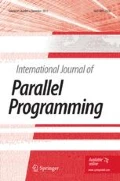Abstract
When collecting the Internet of Things data using various sensors or other devices, it may be possible to miss several kinds of values of interest. In this paper, we focus on estimating the missing values in IoT time series data using three interpolation algorithms, including (1) Radial Basis Functions, (2) Moving Least Squares (MLS), and (3) Adaptive Inverse Distance Weighted. To evaluate the performance of estimating missing values, we estimate the missing values in eight selected sets of IoT time series data, and compare with those imputed by the standard kNN estimator. Our experiments indicate that in most experiments the estimation based on the Lancaster’s MLS is the best. It is also found that the number of nearest observed values for reference and the distribution of missing values could strongly affect the accuracy of imputation.













Similar content being viewed by others
References
Ahmed, S.H., Rani, S.: A hybrid approach, smart street use case and future aspects for internet of things in smart cities. Future Gener. Comput. Syst. 79, 941–951 (2018). https://doi.org/10.1016/j.future.2017.08.054
Alaa, M., Zaidan, A.A., Zaidan, B.B., Talal, M., Kiah, M.L.M.: A review of smart home applications based on Internet of Things. J. Netw. Comput. Appl. 97, 48–65 (2017). https://doi.org/10.1016/j.jnca.2017.08.017
Beveridge, S.: Least squates estimation of missing values in time series. Commun. Stat.–Theory Methods 21(12), 3479–3496 (1992). https://doi.org/10.1080/03610929208830990
Bhattacharjee, S., Mitra, P., Ghosh, S.K.: Spatial interpolation to predict missing attributes in GIS using Semantic Kriging. IEEE Trans. Geosci. Remote Sens. 52(8), 4771–4780 (2014). https://doi.org/10.1109/TGRS.2013.2284489
Borgia, E.: The internet of things vision: Key features, applications and open issues. Comput. Commun. 54, 1–31 (2014). https://doi.org/10.1016/j.comcom.2014.09.008
Cuomo, S., Galletti, A., Giunta, G., Marcellino, L.: Reconstruction of implicit curves and surfaces via RBF interpolation. Appl. Numer. Math. 116(SI), 157–171 (2017). https://doi.org/10.1016/j.apnum.2016.10.016
Ding, Z., Mei, G., Cuomo, S., Xu, N., Tian, H.: Performance evaluation of gpu-accelerated spatial interpolation using radial basis functions for building explicit surfaces. Int. J. Parallel Program. (2017). https://doi.org/10.1007/s10766-017-0538-6
Haara, A., Maltamo, M., Tokola, T.: The k-nearest-neighbour method for estimating basal-area diameter distribution. Scand. J. Forest Res. 12(2), 200–208 (1997). https://doi.org/10.1080/02827589709355401
Hui, T.K., Sherratt, R.S., Snchez, D.D.: Major requirements for building smart homes in smart cities based on internet of things technologies. Future Gener. Comput. Syst. 76, 358–369 (2017). https://doi.org/10.1016/j.future.2016.10.026
Karkouch, A., Mousannif, H., Moatassime, H.A., Noel, T.: Data quality in internet of things: a state-of-the-art survey. J. Netw. Comput. Appl. 73, 57–81 (2016). https://doi.org/10.1016/j.jnca.2016.08.002
Kouicem, D.E., Bouabdallah, A., Lakhlef, H.: Internet of things security: a top-down survey. Comput. Netw. (2018). https://doi.org/10.1016/j.comnet.2018.03.012
Lu, G.Y., Wong, D.W.: An adaptive inverse-distance weighting spatial interpolation technique. Comput. Geosci. 34(9), 1044–1055 (2008). https://doi.org/10.1016/j.cageo.2007.07.010
Mei, G.: Evaluating the power of GPU acceleration for IDW interpolation algorithm. Sci. World J. (2014). https://doi.org/10.1155/2014/171574
Mei, G., Xu, L., Xu, N.: Accelerating adaptive inverse distance weighting interpolation algorithm on a graphics processing unit. R. Soc. Open Sci. (2017). https://doi.org/10.1098/rsos.170436
Ouaddah, A., Mousannif, H., Elkalam, A.A., Ouahman, A.A.: Access control in the internet of things: big challenges and new opportunities. Comput. Netw. 112, 237–262 (2017). https://doi.org/10.1016/j.comnet.2016.11.007
Poulos, J., Valle, R.: Missing data imputation for supervised learning. Appl. Artifi. Intell. 32(2), 186–196 (2018). https://doi.org/10.1080/08839514.2018.1448143
Qi, J., Yang, P., Min, G., Amft, O., Dong, F., Xu, L.: Advanced internet of things for personalised healthcare systems: a survey. Pervasive Mobile Comput. 41, 132–149 (2017). https://doi.org/10.1016/j.pmcj.2017.06.018
Ray, P.: A survey on internet of things architectures. J. King Saud Univ. Comput. Inf. Sci. (2016). https://doi.org/10.1016/j.jksuci.2016.10.003
Shepard, D.: A two-dimensional interpolation function for irregularly-spaced data. In: Proceedings of the 1968 23rd ACM national conference, pp. 517–524 (1968)
Shtiliyanova, A., Bellocchi, G., Borras, D., Eza, U., Martin, R., Carrere, P.: Kriging-based approach to predict missing air temperature data. Comput. Electron. Agric. 142(A), 440–449 (2017). https://doi.org/10.1016/j.compag.2017.09.033
Silva, B.N., Khan, M., Han, K.: Towards sustainable smart cities: a review of trends, architectures, components, and open challenges in smart cities. Sustain. Cities Soc. 38, 697–713 (2018). https://doi.org/10.1016/j.scs.2018.01.053
Sovilj, D., Eirola, E., Miche, Y., Bjrk, K.M., Nian, R., Akusok, A., Lendasse, A.: Extreme learning machine for missing data using multiple imputations. Neurocomputing 174, 220–231 (2016). https://doi.org/10.1016/j.neucom.2015.03.108
Stekhoven, D.J., Buehlmann, P.: MissForest-non-parametric missing value imputation for mixed-type data. Bioinformatics 28(1), 112–118 (2012). https://doi.org/10.1093/bioinformatics/btr597
Stojkoska, B.L.R., Trivodaliev, K.V.: A review of internet of things for smart home: Challenges and solutions. J. Clean. Prod. 140, 1454–1464 (2017). https://doi.org/10.1016/j.jclepro.2016.10.006
Tang, F., Ishwaran, H.: Random forest missing data algorithms. Stat. Anal. Data Min. 10(6), 363–377 (2017). https://doi.org/10.1002/sam.11348
Trappey, A.J.C., Trappey, C.V., Govindarajan, U.H., Chuang, A.C., Sun, J.J.: A review of essential standards and patent landscapes for the Internet of Things: a key enabler for Industry 4.0. Adv. Eng. Inf. 33, 208–229 (2017). https://doi.org/10.1016/j.aei.2016.11.007
Tsai, C.F., Li, M.L., Lin, W.C.: A class center based approach for missing value imputation. Knowl. Based Syst. 151, 124–135 (2018). https://doi.org/10.1016/j.knosys.2018.03.026
Tzounis, A., Katsoulas, N., Bartzanas, T., Kittas, C.: Internet of things in agriculture, recent advances and future challenges. Biosyst. Eng. 164, 31–48 (2017). https://doi.org/10.1016/j.biosystemseng.2017.09.007
Acknowledgements
This work was supported by the Natural Science Foundation of China (Grant Numbers 11602235 and 41772326), the College Students Innovation and Entrepreneurship Training Program (201811415014), the Fundamental Research Funds for the Central Universities (2652017086).
Author information
Authors and Affiliations
Corresponding author
Additional information
Publisher's Note
Springer Nature remains neutral with regard to jurisdictional claims in published maps and institutional affiliations.
Rights and permissions
About this article
Cite this article
Ding, Z., Mei, G., Cuomo, S. et al. Comparison of Estimating Missing Values in IoT Time Series Data Using Different Interpolation Algorithms. Int J Parallel Prog 48, 534–548 (2020). https://doi.org/10.1007/s10766-018-0595-5
Received:
Accepted:
Published:
Issue Date:
DOI: https://doi.org/10.1007/s10766-018-0595-5




